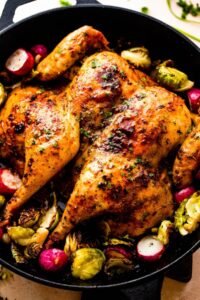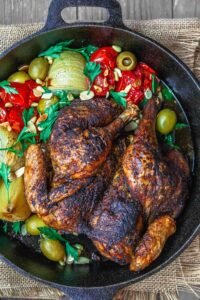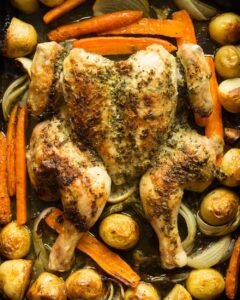To all intents and purposes, a chicken that has been spatchcocked would be regarded as a potentially hazardous animal. However, when it comes to roasting a chicken, spatchcocking is actually one of the most fundamental and effective procedures that may be utilized. Could you kindly give us the opportunity to explain?
There is a possibility that roasting an entire chicken will be a challenging endeavor. It is essential to roast the chicken for an adequate amount of time in order to ensure that the dark meat of the bird is cooked through to the point of being completely cooked. Nevertheless, it is of the utmost importance to prevent the remaining parts of the bird from drying out while the chicken is being roasted. In the event that you place an order for our roasted spatchcock chicken, you won’t have to be concerned about the problem of dry flesh.
The exposed surface of the pan will not only assist in the cooking of the chicken, but it will also result in the production of a chicken skin that is deliciously crispy. Your chicken that has been spatchcocked, along with Brussels sprouts, carrots, and garlic, can be roasted in a single pan to produce a dish that is easy enough to prepare on weeknights and elegant enough to be displayed gracefully at parties. This recipe can be prepared in a single pan.

For the purpose of preparing a roast chicken that is not only delicious but also more time-efficient, it is essential to acquire the technique of spatchcocking chicken.
Exactly what does it mean when someone says they are “spatcocking”?
It has been shown that the term “spatchcocking” originates from Ireland and can be traced back to the 18th century. This is a fact that has been established. The term “spatch” is a reduction of the word “dispatch,” while the term “cock” refers to a male fowl (chicken). When broken down into its component elements, the phrase “spatch” is a reduction of the previous word. These two terms are derived from the same root word, which is the same word. Over the past few years, there has been a significant increase in the number of individuals who are engaged in patchcocking all over the world. There is simply no competition when it comes to a chicken that is cooked in a consistent manner and has a skin that is beautifully crispy in a short amount of time. This chicken is the best there is.
Ingredients for Roasting Spatchcock Chicken
This recipe explains how to make the ideal spatchcocked chicken. Once you’ve mastered the technique, you can experiment with different herbs and spices to suit your preferences. To prepare this roasted spatchcock chicken, you will need:
Chicken
Whole chicken: The star of the show—use any size chicken you like, increasing the roasting time until the thickest section of the meat reaches 165°F.
Garlic cloves: Make a rich garlic butter to give the chicken a rich, delicious flavor.
Kosher salt: season the fowl.
Salted butter adds flavor to the bird, crisps up the skin, and keeps the flesh juicy.
Fresh thyme provides a flowery note. If you like, you can substitute parsley or sage.
Lemon zest and juice: The citrus taste lends brightness to the roasted chicken.
Black pepper: Add a dash of peppery spiciness.
Small red new potatoes: These potatoes have a pleasantly sweet flavor, creamy texture, and thin, delicate skin. If needed, use Yukon Gold or other types of baby potatoes.

Small carrots are a typical accompaniment to roasted chicken.
Brussels sprouts are an earthy vegetable that roasts to a soft inner and crunchy exterior, helping to complete the meal.
How to Prepare Roasted Spatchcock Chicken
Roasting a beautiful chicken has never been easier or faster, with only 25 minutes of active time and 50 minutes of cooking. Full instructions are below, but here’s a quick refresher before you begin:
Step 1: Prepare the oven and chicken. Preheat the oven to 450°F. Rinse and pat the chicken dry.
Step 2: Remove the chicken’s backbone by cutting around it.
Step 3: Open the chicken and press forcefully on the breastbone until it fractures.
Step 4: Place the chicken on a baking sheet. Transfer to a large, rimmed baking pan. Tuck the wing tips underneath the bird.
Step 5: Make garlic-herb butter by mashing garlic and salt into a paste. Mix in the butter, thyme, zest, and pepper. Rub under the skin of the breasts and thighs, saving two tablespoons.
Step 6: Roast the chicken for 10 minutes.
Step 7: Add vegetables to the pan. Remove the pan and reduce the oven temperature to 400°F. Arrange potatoes and carrots around the chicken; bake for 20 minutes. Add the Brussels sprouts and put the remaining garlic butter over the breasts; bake for about 20 minutes, or until the chicken reaches 165°F.
Step 8: Add lemon juice and serve. Drizzle with lemon juice. Allow to rest, then carve and serve.
Variations to Roasted Spatchcock Chicken
Once you’ve mastered removing the breastbone and flattening the chicken, you may experiment with different components to create the quick and simple supper of your dreams.
Swap the bird: You may successfully spatchcock cornish game hens, small turkeys, and ducks.
Mix together the garlic-herb butter. For umami flavor, stir in chopped parsley, rosemary, or other herbs with the butter and Parmesan cheese.
Mix up the vegetables. Onions, peppers, cauliflower, mushrooms, asparagus, green beans, and fennel all roast well alongside chicken. Add more fragile veggies, such as cherry tomatoes or squash, near the end of cooking.
If you don’t want potatoes, roast the chicken and vegetables instead. Serve with rice, spaghetti, or your favorite side dish.
For a finishing touch, serve this meal with pan gravy, pesto, aioli, balsamic glaze, or any other favored sauce.
How to Store and Heat Leftover Roasted Spatchcock Chicken
Keep leftover chicken and vegetables in an airtight container or plastic zip-top bag for up to four days. Before serving, reheat the beef, covered, in a preheated 350°F oven until it reaches 165°F. You can also microwave smaller amounts until thoroughly heated. If the chicken or vegetables appear dry, add a dash of broth while cooking to preserve their original flavor.
More Spatchcocking Recipes You Will Love
Are you ready for a holiday game-changer? Try our Spatchcock Turkey and Spatchcocked Smoked Turkey recipes for quick, consistent cooking and crispy skin. You might not look back.
Ingredients
- 1 (5-lb.) whole chicken
- 4 garlic cloves, chopped
- 1 tsp. kosher salt
- 6 Tbsp. (3 oz.) salted butter, softened
- 1 Tbsp. chopped fresh thyme
- 2 Tbsp. lemon zest, plus 3 Tbsp. fresh juice (from 2 lemons), divided
- 3/4 tsp. black pepper
- 12 oz. small red new potatoes, halved
- 8 oz. small carrots with tops, trimmed
- 8 oz. Brussels sprouts, trimmed and halved
Directions
Prepare oven and chicken:
Preheat oven to 450°F. Rinse chicken, and pat dry.
Remove backbone:
Place chicken, breast side down, on a cutting board. Using poultry shears, cut along both sides of backbone, and remove backbone. (Discard or reserve for stock.)
Press against breastbone:
Turn chicken breast side up, and open the underside of chicken like a book. Using the heel of your hand, press firmly against breastbone until it cracks.

Place chicken on baking sheet:
Place chicken in a large rimmed baking pan. Tuck wing tips under chicken so they don’t burn.
Make garlic-herb butter:
Combine garlic and salt on a cutting board. Using the flat edge of a knife, mash into a paste. Combine garlic paste, butter, thyme, zest, and pepper in a bowl. Set aside 2 tablespoons of the garlic mixture. Rub remaining garlic mixture under skin of chicken breasts and thighs.
Roast chicken:
Bake chicken in preheated oven 10 minutes.
Add vegetables to baking pan:
Remove pan from oven. Reduce heat to 400°F. Arrange potatoes and carrots around chicken; return to oven, and bake 20 minutes.
Arrange Brussels sprouts around chicken, and spread remaining 2 tablespoons garlic mixture on breasts; return to oven, and bake until a meat thermometer inserted in thickest portion registers 165°F, about 20 minutes.
Add lemon juice, and serve:
Drizzle with lemon juice, and let stand 10 minutes. Carve chicken, and serve with pan juices.
FAQ:
Why spatchcock a chicken?
Spatchcocking a bird, which enables it to cook more evenly and more rapidly, ultimately results in flesh that is more juicy and skin that is crispier. Spatchcocking is a more traditional method of cooking. As a method of cooking birds, the process known as “spatchcocking” is utilized. One more advantage is that it makes the process of carving and displaying the product easier to do.
Can I season the chicken in advance?
In order to prepare the chicken for cooking, it is possible to season it for a few hours or even overnight. This is something that may be done while the chicken is still in the cooking process. Because of this, the spices are able to penetrate the flesh to a greater degree than they would have been able to do in any other circumstance. A chicken that has been seasoned should be kept in the refrigerator until it is ready to be cooked. This should be done as soon as possible. In order to accomplish this, the chicken must first be placed in the refrigerator and then wrapped tightly in plastic wrap before being cooked.
What should I do with the backbone?
Keeping the backbone of the bird and incorporating it into the process of making broth or stock from chicken stock is something that can be done. A great stock may be made by simply freezing it until you are ready to use it and then boiling it with water, aromatics, and any vegetable scraps that you have on hand. This process can be repeated as many times as you like. You may expect your stock to be tasty.
Can I cook spatchcock chicken on the grill?
The fact of the matter is that chicken that has been spatchcocked is an excellent choice for eating on the barbecue. After preheating the grill to a temperature that falls somewhere between medium and high, the chicken should be cooked for approximately ten to fifteen minutes with the skin side down. This recommendation is made after the grill has been warmed. Turn it over and continue cooking it until the internal temperature reaches 165 degrees Fahrenheit (74 degrees Celsius) and the skin has become crispy. This is the next phase in the process.
How do I know when the chicken is done?
Utilizing a meat thermometer is the most effective method for ensuring that the chicken is cooked all the way through. This is because the thermometer measures the temperature of the flesh. In order to accurately determine the temperature of the bird, the thermometer should be inserted into the thickest section of the bird, avoiding the bone. With a temperature of 165 degrees Fahrenheit (74 degrees Celsius), the ideal temperature would be:
ALSO READ: Chicken Cordon Bleu
